STREET ART TOUR in BILBAO

Many places we’ve visited in the past are littered with graffiti, and although we enjoy art in every form, we enjoy it when it is respectful to the city, its architecture and the people. Bilbao did have a lot of street art, and some graffiti, but I felt it was done in places that were appropriate without being disrespectful to the community.
There are many walking tours available in Bilbao from self-guided to provided service, and they range from food to architecture to art. A current topic of interest to many these days is murals and street art, naturally we sought that out. Street art can be found all across Bilbao, but the most impressive works are concentrated around the Ibaiondo district. We located an online map to guide us through the neighborhood. This (FREE) tour consisted of 22 of the most significant and officially-commissioned pieces; we found all but one (which we believe might have been torn down as part of a new construction project). We did see additional works and graffiti along the way as well as a few very interesting sculptures.
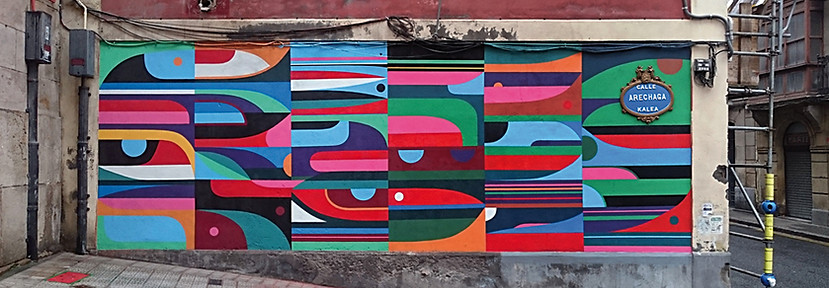
DAY TWO:
SHORELINE ADVENTURE & SCULPTURE TOUR

Even though we were in Spain for the month of December, the weather was really very mild. It was sunny and averaged 60 degrees Fahrenheit; multiple light layers and a backpack to carry shed off items was a comfortable way to experience the entire day.
Today we are concentrating on art and adventure by exploring the shoreline from one end to the other. We started by strolling along the western beach until we found a cafe to sip coffee and have a light bite. People were out jogging, walking their dogs, a few of the serious were folks were swimming laps in the bay - brrrrr.
The first sculpture we passed was Dove of the Peace, an impressive white metal sculpture that stands nearly 23 feet high, created by artist Nestor Basterretxea. Designed in the ’80s, this sculpture is meant to represent the commitment San Sebastian has to freedom, harmony, and peace.
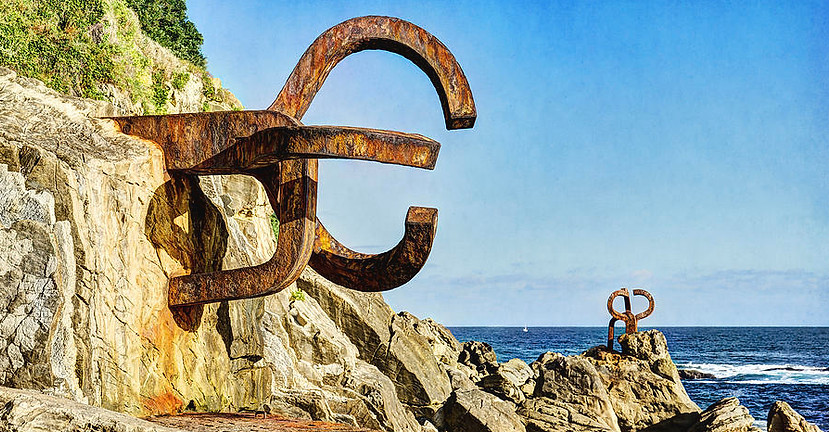
Continuing to the end of the promenade is the most iconic sculpture installation in San Sebastian called the Comb of the Wind. It is a grouping of three sculptures by Eduardo Chillida arranged by architect Luis Peña Ganchegui as an architectural work. The piece was installed in 1976 and is the most important work in both artist’s careers. The cliffside here serves as a rocky park with these sculptures arranged to perfection in a subtle but obvious way with nature. This is definitely a place where, as you wait your turn to take a selfie, you can relax with the wind blowing through your hair listening to the water break against the rocks.
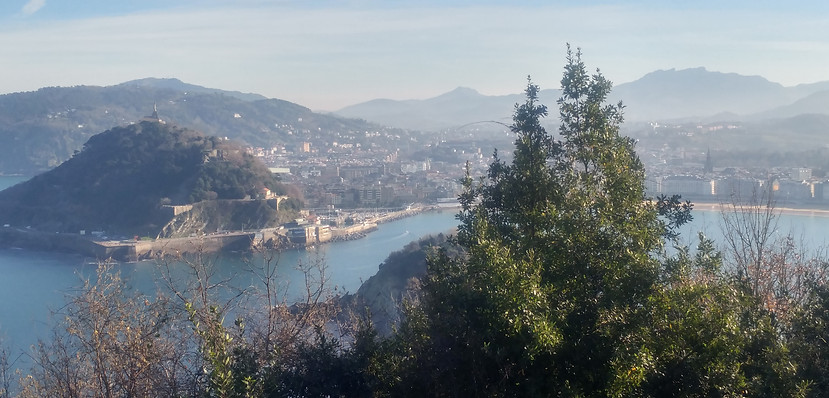
Onward to explore the elevations of Monte Igueldo. There are a few ways to reach the top of Monte Igueldo: by funicular, by car, or on foot. We choose the foot option which was a mix of road, sidewalk, and staircases; the trec took approximately 30 minutes to the top. On the way up you walk amongst the unique homes overlooking the bay; as you wind around the peninsula there are quiet beaches and rolling forests - it’s really a great way to experience what might be like to actually live in San Sebastian. A lighthouse, built in 1855, juts from the mountainside, in the most beautiful setting. This lighthouse took the place of the tower located at the peak of Monte Igueldo, which dates from 1748. The new lighthouse was not open for tours or exploration when we were there, but check to see if it'll be open when you visit. The walk was peaceful and the views were worth it. Whether you walk, ride or drive there is a small fee to enter the top area where a resort area and a small amusement park sits. The views are what most come for. As the entire resort area was under construction, we chose to walk back down and enjoy the sunshine and views which were just as beautiful going the other way.
AAT-TIP: If you are into shopping and you have not had a chance to get that in, this is the place to head into town, for the best boutique shopping in the Antiguo neighborhood.
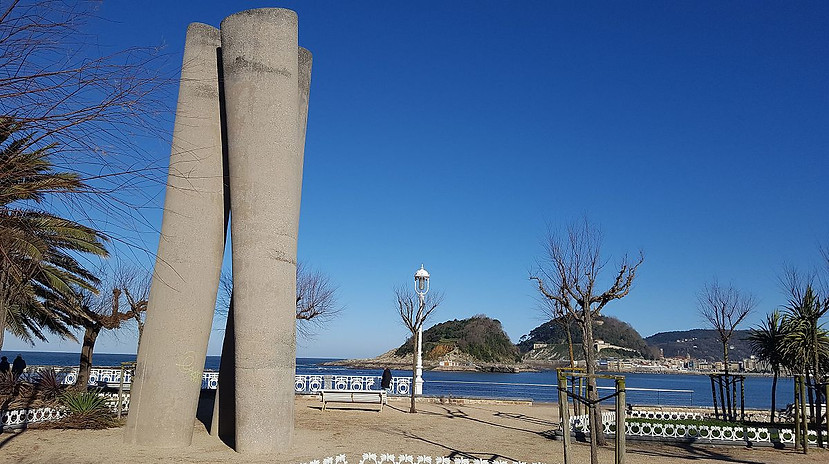
At the base of Monte Igueldo, off the western coastline, is Ondarreta Gardens which hosts the next sculpture called Zeharki, this work was created in 1983 by Navarra-born artist José Ramón Anda, and consists of three large-scale irregular concrete cylinders that lean together to form a contemporary monument. You can walk up, around, and thru the sculpture, as you enjoy the piece and its setting.
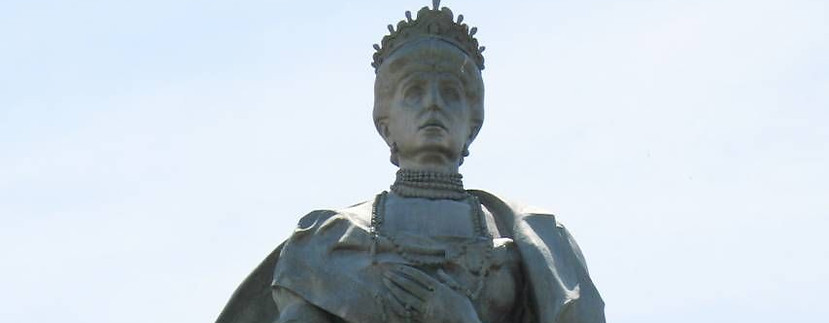
In 1887 Queen Maria Cristina of Hapsburg-Lorraine moved the royal court’s summer retreat to San Sebastian. As a memento of this, also in the Ondarreta gardens is Monument to Queen Maria Cristina a traditionally-designed bronze sculpture created by José Díaz Bueno. This beautiful piece shows off and educates us on the history and culture of the area.
We took a detour here to check out the huge monastery midway up the mountain (which we’d noticed from our vantage point at the top of Monte Igueldo); although the hike up was enjoyable, and walking through the neighborhoods was interesting, this was not a detour worth the destination. The building was beautiful and impressive, but entry was not permitted, nothing was going on, and there was not any information about the history or background of the area.

Once we made it back to the beachside walkway of Paseo de la Conch it was almost easy to overlook a sculpture called Homage to Fleming by Eduardo Chillida, which honors Alexander Fleming, the inventor of penicillin. This piece was originally created in iron in 1955, the year of Fleming's death. In 1990 the Chillida recreated the piece you see on the shoreline today.

Continuing on to the end of Paseo Nuevo you will see the beautiful work Tribute to the Basque Pelota Player by José Alberdi. This 13-foot sculpture, located next to the pelota court and church of Saint Sebastian Mártir, was commissioned by the San Sebastian City Council as a tribute to the sport and its players. Pelota is a really big deal in Basque country - during our stay, tournaments were broadcast seemingly 24 hrs.
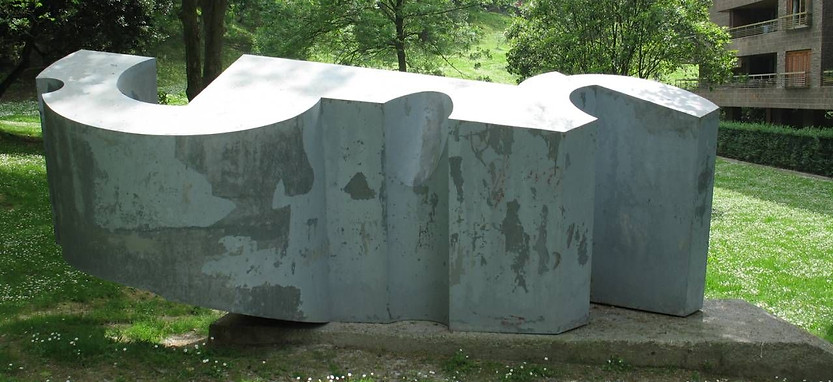
Just a little further down the Pio Baroja promenade is this 20-foot horizontal metal work with a beautiful patinated finish called Monument to Pío Baroja, a tribute to the Spanish writer, by artist Nestor Basterretxea, and dated 1972.
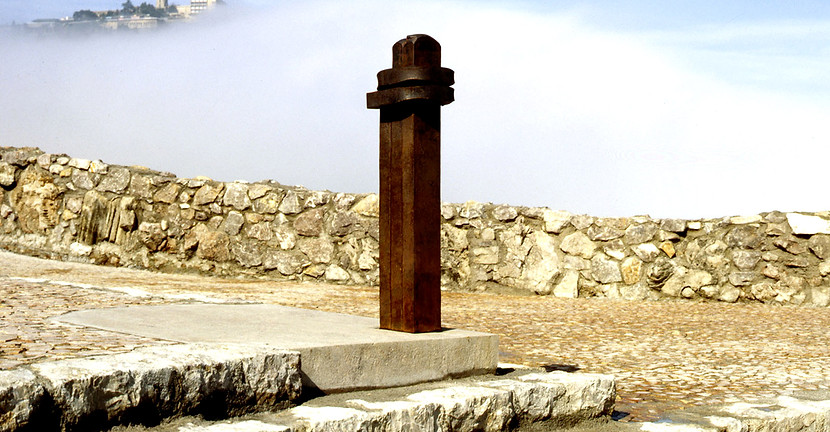
Rounding out Paseo de la Conch at Pico del Loro is The Embrace which dates back to 1992. This iron sculpture, with a beautiful rustlike patina, was created and donated by Eduardo Chillida as a tribute to Rafael Ruiz Balerdi, a Spanish painter and friend of his. Don’t miss this piece it stands just over 3 feet tall.
As we continue down the beach I was constantly to be amazed to see people and their pets enjoying the beaches. The surfers were out there catching the waves, the dogs were happy retrieving balls, sticks, and frisbees- it was a beautiful day! Make sure to reserve some time for yourself to enjoy the setting.
From nearly every vantage point of San Sebastian, you can see the Monument to the Sacred Heart on the top of Monte Urgull located at the end of La Concha Bay. That was going to be our final hiking destination before dinner.
The hike up Monte Urgull looked a little intimidating, but the pathways were paved and the stairways were well maintained. We took it slow and steady and the climb really was not that bad. All along the way, there were benches or places to stop and see new vantage points, panoramic views of the city, and historical markers. There was a light stream of people coming and going. Once we made it to the top we were amazed at all there was to see and explore.

The city’s military history comes alive on top of Monte Urgull. Serving as a lookout since 1180, this area was converted into a military fortress in the 12th century. As you walk along, you will discover remaining structures and ruins from various historical periods, as well as part of the wall that once surrounded Donostia/San Sebastian; one of the few remaining artifacts from the battles and sieges that the city withstood from as early as the 14th century.
There are four different pathways around the area that allow you to enjoy views of the city and scenic lookout points. There is also a path that will take you to the summit, with the fortifications and the Sagrado, which is what we came for!
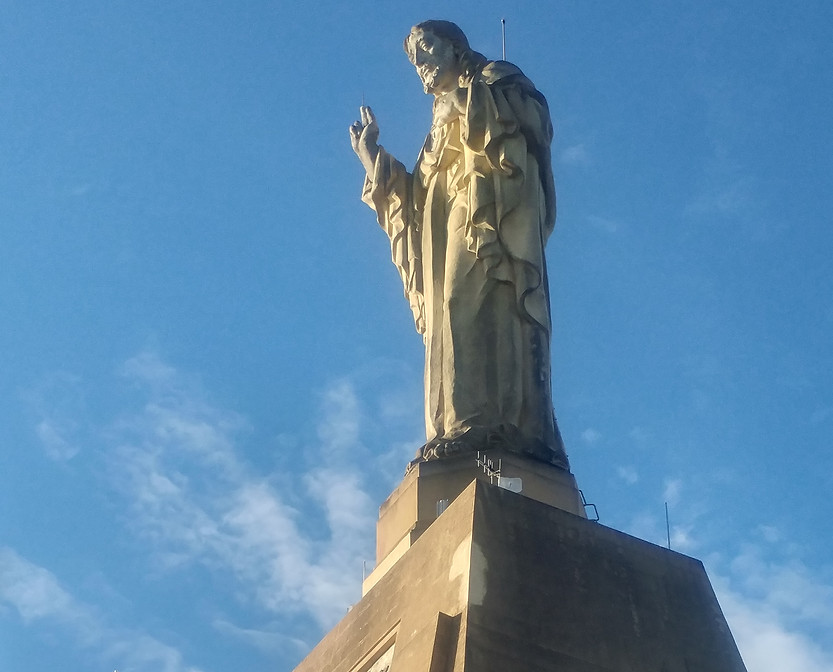
The idea of the Sagrado Corazon / Monument to the Sacred Heart was conceived of by the civil, military, and church authorities in 1926, and was created by sculptor Federico Collaut-Valera. The dimension of the structure is monumental, the chapel and the figure together are 95 feet in height, the statue itself is 40 feet in height. It is said that the work is visible from as far as four miles out to sea.
AAT-TIP: As this is an open-air site, this is a perfect option for during siesta - take a picnic or beverage - relax and enjoy the views. During the warmer months there is a small outdoor bar/cafe that is open for Monte Urgull visitors.
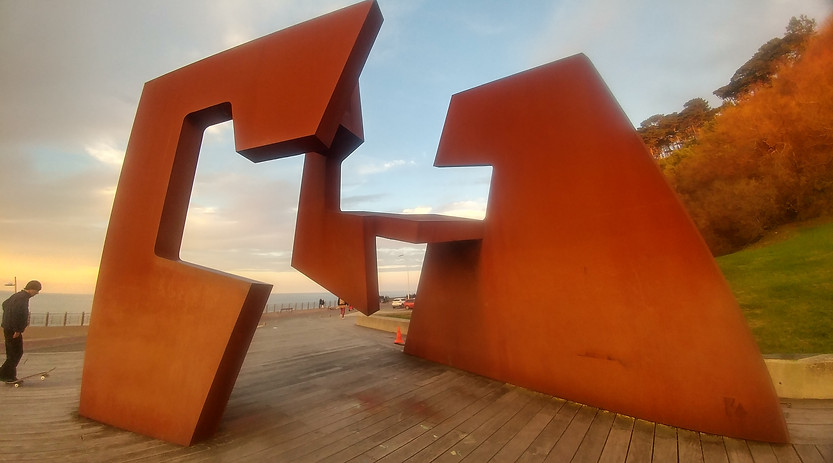
Done exploring? there are multiple paths down. Take the path toward Paseo Nuevo so you can walk along the boardwalk and watch the sunset. As you walk along the walkway which borders Monte Urgull, you will find yet another impressive sculpture Open Construction by Jorge Oteiza, another famous Basque sculptor. This piece consists of two huge steel pieces that weigh a total of 23 tons. This is the perfect location for this piece; Paseo Nuevo is renowned for its spectacular breaking waves. Keep an eye on the water, you might get wet!
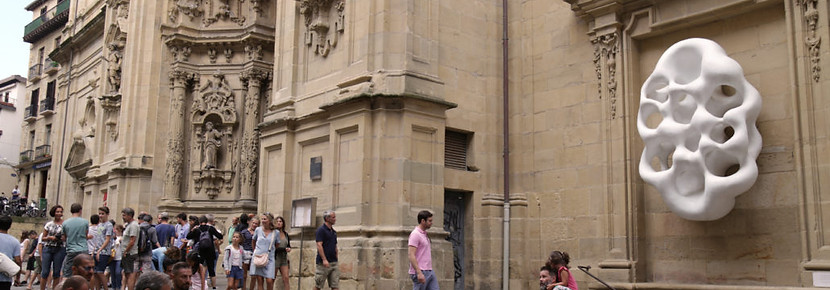
As the sun sets, the streets come alive again as the locals, and visitors, come out for drinks and pintxos. Head toward the old town area, where you have an amazing array of pintxo-and gastrobars to choose from. Here we spotted another inconspicuous work of art that we were glad to have seen. Across from the Atari Gastroteka, on the Basilica of Santa del Maria del Coro is a bright white piece of contemporary art that is beautiful but a seemingly odd juxtaposition against the cathedral's historic stone facade. The work is an oval form with holes that have a soothing feeling as it sits on the cool angular cathedral. This piece is called The Harmony of Sound by artist Maximilian Pelzmann, and was inspired by the hymn “Ave Maria” - referencing visions of the ocean and choral waves coming and going.
AAT-TIP: Everywhere you go you will be delighted with the Basque bites (pintxos) and wine. My favorite two in the old town area were: the beef cheeks at La Cuchara de San Telmo and the wild mushroom plate at Ganbara … still thinking about them.
San Sebastian is filled with much more art and culture than I mentioned, or that we even had the chance to see in this short visit. I hope you find these places as amazing as we did. Please let us, and our followers, know your thoughts and comments!
HOME | BACK TO SAN SEBASTIAN
DAY ONE: Arts and culture tour